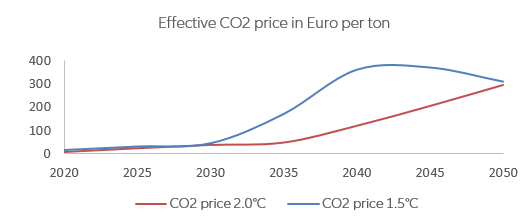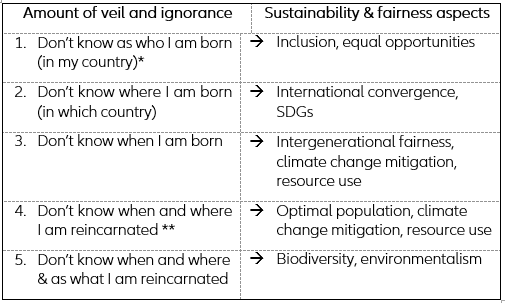The fiscal burdens from Germany’s ambitious climate policies pile up only after 2030. In recognizing this, and labelling the 2019 climate protection law as partly unconstitutional as a result, Germany's Constitutional Court attempts to hardwire future generations’ interests into the political process. This could spark a tectonic shift for future climate action. Using calculations for a representative archetype in projections that match the scenarios provided by the Network of Central Banks and Supervisors for Greening the Financial System (NGFS), Figure 1 shows that increasing ambitions from the current 2°C trajectory to a 1.5°C trajectory doesn’t have large effects on carbon and average electricity prices up to 2030 . This is due to strongly declining global investment costs in a coordinated 1.5°C scenario for the typical renewables, resulting from cost reductions through economies of scale. The large cost burden materializes between 2030-2050 as the more ambitious scenario requires a much larger employment of photovoltaic capacity in combination with earlier and larger hydrogen capacities, as well as a stronger deployment of carbon capture and storage. The constitutional court explicitly addresses the issue of how the financial burden should be shouldered by different generations.
Essential for the redistribution is the question of whether the current generation has the right to destroy the environment. In this case, future generations would have to compensate them in order for today’s generation to not destroy their future livelihood. Alternatively, if future generations have the right to demand the protection of their livelihoods, the current generation has to compensate them for polluting the environment today. The current political praxis is oriented around the former while the constitutional court ruling could be interpreted in the way that favors the latter interpretation.
Figure 1 – Effect of increasing climate ambitions on CO2 & electricity prices
What if you were a fish in the future? That is, according to the constitutional court, bad luck for you. It points out that the right to a constitutional complaint is exclusive to natural (human) persons, even if they are children from Nepal or Bangladesh. On the other hand, such complaints by NGOs as “advocates for nature” are not admissible. Moreover, the court’s ruling highlights our societies’ shortcomings in dealing with long-term issues such as climate change, described by former Bank of England governor Mark Carney as “the tragedy of the horizon”. Part of the tragedy can easily be demonstrated with a simply numerical example. Imagine a policy that – given a cost for current generations – increases the wellbeing of all future generations. Let the benefit be an improvement in the form of an annual USD100 cash flow that starts in 100 years and runs to infinity. The calculated net present value (NPV) of that cash flow is the maximum cost financial markets would be willing to spend today to realize that future cash flow. Unfortunately, the NPV is largely dependent on your required rate of return. For the numerical example, let us just compare the rate of return applied in US climate policy. While the Trump administration raised the rate from 3% to 8% for the calculation of the social cost of carbon, a prominent group of advocates urges the Biden administration to reduce this rate to 1%. As calculated below, at 1%, this future cash flow has a NPV of around USD3,700 while at 8% it is just worth 57 cents.
Consequently, under a required rate of return of 1%, a policy actor would be willing to spend USD3,700 today to realize this cash flow for future generations. Under 8%, the future is basically worthless, an assessment the affected future generations themselves will hardly agree on.
The constitutional court ruling raises the question of whether thinking in terms of NPV is the right approach at all (even if a small required rate of return is chosen). Its philosophy is rather to extend the concept of Rawls’ veil of ignorance, which is deeply anchored in the constitution. It is no longer sufficient to live in a society that is just for its current citizens (no matter if they are female or male, rich or poor, healthy or ailing, strong or weak, intellectual or practical, privileged or disadvantaged). The constitutional court rather clarifies that for certain (long-term) issues, a political process based on the votes of the current generation (even if they were under a veil of ignorance, not knowing who they are) tends to shift an unfair burden share on future generations that don’t have a vote yet, and thus violates the principle of justice.
The concrete obligation for the legislation to explicitly specify the long-term transition pathways after the year 2030 seems a manageable task, but even more important are the clarifications that don’t imply a concrete current action by the legislation. Most notably, the constitutional court emphasizes that it is an objective constitutional duty to protect future generations’ “… life and health against the risks posed by climate change, including climate-related extreme weather events such as heat waves, forest fires, hurricanes, heavy rainfall, floods, avalanches and landslides. … Since climate change can moreover result in damage being caused to property such as agricultural land or real estate (e.g. due to rising sea levels or droughts), the fundamental right to property also imposes a duty of protection on the state with regard to the property risks caused by climate change. … As intertemporal guarantees of freedom, fundamental rights afford the complainants protection against comprehensive threats to freedom caused by the greenhouse gas reduction burdens that are … being unilaterally offloaded onto the future. The legislator should have taken precautionary steps to ensure a transition to climate neutrality that respects freedom – steps that have so far been lacking.” (See Appendix for a list of further important clarifications that we will repeatedly encounter in upcoming policy discussions.)
How can the “intertemporal guarantees of freedom” be addressed in an economic framework for policy analysis that goes beyond NPV calculation? Table 1 lists how the commonly employed concept of the veil of ignorance can be extended to cover a broader range of policy issues.
Table 1 – The right amount of veil and ignorance
The first and basic concept relates to the typical applications that implicitly assume the analyzed society to consist of current citizens of a country. This analysis is useful for inclusion or equal opportunity issues. Further defining the society beyond national borders in the second concept motivates justice in the sense of international convergence, for instance in form of the United Nations Sustainable Development Goals (SDGs). To address issues of intergenerational fairness in the third concept, the veil of ignorance should hide the knowledge of when you will be born. The fourth concept combines the second and third and seems particularly relevant for the assessment of climate action in the spirit of the constitutional court. In a current study, for instance, David de la Croix and Matthias Doepke provide a suitable analytical framework that employs the idea of reincarnation to derive optimized policies for intertemporal problems of this type. You don’t have to believe in reincarnation to share the intuitive idea that behaving as if you regard the interest of your future reincarnated self is an equivalent to incorporate the wellbeing of future generations. Finally, in the fifth concept we conclude with the possibility of you being reincarnated as a fish. While the constitutional court mentions that this goes beyond the current coverage of the basic rights, it poses an intuitive approach to assess biodiversity issues beyond the anthropocentric value of nature.
The constitutional court ruling could be interpreted as lifting the bar for policymakers by moving from the first to the forth concept. This is an important step in avoiding nihilistic discounting and finding a fair value system that respects the current and future you and me.







